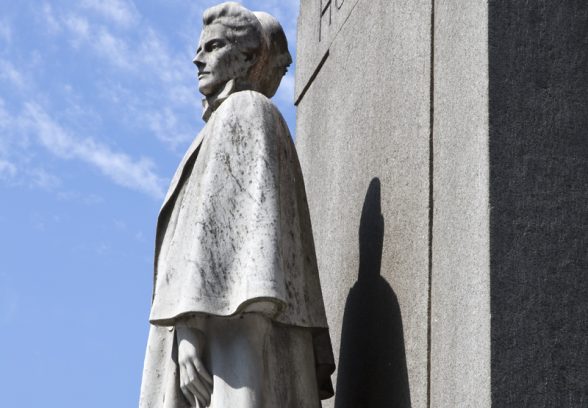This website uses cookies
This website uses cookies to enable it to function properly and to analyse how the website is used. Please click 'Close' to accept and continue using the website.




London: Memorial to Edith Cavell
Status: Listed Grade II
Architect: Sir George Frampton (1860-1928)
Location: St Martin's Place, London
Edith Cavell (1865-1915) was a British nurse based with the Red Cross in occupied Belgium. She treated both armies, but helped hundreds of Allied soldiers escape to the Netherlands. She was arrested in August 1915 on the charge of harbouring prisoners or war, having been incriminated by resistance documents and a thank-you card sent by one escapee. She was imprisoned for ten weeks (the last two in solitary confinement) before being court-martialled. She confessed in full to her crimes and was executed by a firing squad at dawn. The night before her execution she told the Anglican chaplain, Reverend H. Stirling Gahan, who had been allowed to see her and to give her Holy Communion, “Patriotism is not enough, I must have no hatred or bitterness towards anyone”.
Cavell’s death quickly became the subject of Allied propaganda worldwide, the nurse becoming the most prominent female casualty of the Great War. The events were twisted into a tale of her fainting, and being executed by a single shot from a revolver. The image of the heroic nurse was quickly illustrated as an example of German brutality in postcards and contemporary press. In many she was depicted as a nubile girlish nurse (as opposed to her 49 years) implying that men should enlist to stop the murder of innocent British girls. Elsewhere, she was portrayed as a mature, patriotic woman, a mother-figure to troops. After the war, King George V and Queen Mary visited the site of her burial, before her body was exhumed and transported to Westminster Abbey for a state funeral. It was then taken to her home city of Norwich, where she was buried to the east of the cathedral. Around the world streets, hospitals clinics, and even a mountain in the Canadian Rockies have been named after her.
Revealed in 1920, the memorial was criticised for its ‘modernity’ of style, most obvious in the distinctly European (note the Germanic plaits!) Expressionist style of the sculpture to the top. The female figure completes a cross form; she is not a Madonna and Christ child, but rather a mother protecting a female child, with 1920s bobbed haircut. A further fault was the ‘pedestrian’ positioning of the sculpture, overshadowed by the monumental cross.
Sir George James Frampton (1860-1928) began his training in an architect’s office before training at the South London Technical School and the RA before training in Paris. Frampton was known for a symbolist style, often executing figures in a dream-like state. His more famous memorial is the Peter Pan statue in Kensington Gardens (1915). In 1912 he was Presidents of the Royal Society of British Sculptors; making him a central judge in the selection of official war artists and memorials.
Jon Wright
Either enter the name of a place or memorial or choose from the drop down list. The list groups memorials in London and then by country

Become a C20 member today and help save our modern design heritage.